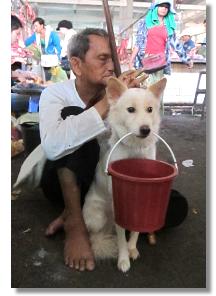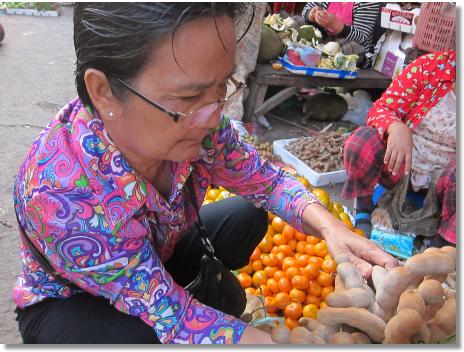 |
|
The Cambodian Market:
Wheel of the Quivering Meat Conception
26-Jan: 2015

I once heard that a Buddhist student asked his Tibetan master if plants were not also sentient beings which we kill when we uproot them, and the teacher replied that they were. "But  you have to draw the line somewhere," the master added. Perhaps we need to widen our circle of compassion. In any case, we survive our lifetime atop the food chain largely thanks to plants (and plants feed the animals we consume). We live in the center of the "quivering meat conception" - a line from a Jack Kerouac poem. To visit a Cambodian market at, say, 8:00 AM, is to put oneself squarely in the center of the quivering so that one can more closely study the existential niche we occupy. But first, a few lines from the poem:
you have to draw the line somewhere," the master added. Perhaps we need to widen our circle of compassion. In any case, we survive our lifetime atop the food chain largely thanks to plants (and plants feed the animals we consume). We live in the center of the "quivering meat conception" - a line from a Jack Kerouac poem. To visit a Cambodian market at, say, 8:00 AM, is to put oneself squarely in the center of the quivering so that one can more closely study the existential niche we occupy. But first, a few lines from the poem:
- The wheel of the quivering meat
conception - Turns in the void expelling human beings,
Pigs, turtles, frogs, insects, flits,
Mice, lice, lizards, rats, roan
Racinghorses, poxy bucolic pigtics,
Horrible unnameable lice of vultures,
Murderous attacking dog-armies
Of Africa, Rhinos roaming
in the jungle,
Vast boars and huge gigantic bull
Elephants, rams, eagles, condors,
Pones and Porcupines and Pills— - All the endless conception of living
beings
- 211th Chorus, from the book Mexico City Blues.
Along with unseen or unnoticed beings - the lice of vultures, rats, tics and bacteria - I noticed countless creatures on my morning walk through the market:  hordes of pineapples, trays of chile peppers, plates, cans and cages of unknown fish, all without water, their gills working in futility, each of them dying slowly in the morning sun. I saw the severed heads of pigs, their gigantic ears as sensitive as their snout, able to localize sounds the way a cat does or detect the more than twenty vocalizations of another swine. I saw rows and rows and rows of beheaded chickens, their stiff feet pointing skyward, plucked and ready to be further dismembered, all of them destined to be inside the human small intestine before tomorrow's dawn. I saw pristine arrangements of limes, carrots and green mangoes. I saw vendors sitting cross-legged on the ground or atop tiny stools, women with kilo scales nearby, embedded within their products. I saw human beings nearly as vulnerable as the grouper and quail sold near them; old men, amputees working a plot of ground and a blind woman begging with her dog who carried a plastic bucket of money in its mouth and stared with intense one-pointedness at approaching potential customers.
hordes of pineapples, trays of chile peppers, plates, cans and cages of unknown fish, all without water, their gills working in futility, each of them dying slowly in the morning sun. I saw the severed heads of pigs, their gigantic ears as sensitive as their snout, able to localize sounds the way a cat does or detect the more than twenty vocalizations of another swine. I saw rows and rows and rows of beheaded chickens, their stiff feet pointing skyward, plucked and ready to be further dismembered, all of them destined to be inside the human small intestine before tomorrow's dawn. I saw pristine arrangements of limes, carrots and green mangoes. I saw vendors sitting cross-legged on the ground or atop tiny stools, women with kilo scales nearby, embedded within their products. I saw human beings nearly as vulnerable as the grouper and quail sold near them; old men, amputees working a plot of ground and a blind woman begging with her dog who carried a plastic bucket of money in its mouth and stared with intense one-pointedness at approaching potential customers.
The market is a form of "charnel ground," the places in Tibet or India were human corpses were simply cut into sections and left to the vultures and flies, places ideal for certain classes of meditators who could tolerate the startling wakefulness of this kind of cemetery. There is certainly a precise intersection of life and death occurring in the market. Pineapple and cauliflower freshly cut and just arrived on the back of a motorcycle or atop a pickup truck. Not to mention the other more obvious sentient creatures. The market is a place of enriching presence and snaps me out of desultory preoccupations and stupor. Enriching presence is the gong clang of now, now, now.
(Essay continues below.)





The name of the market I've been visiting is called Psar Boeung Chouk, which means "Lake of the Lotus." When I returned to the market this morning I found another blind person with dog and begging bucket. He was near the blind woman I'd encountered earlier, and then later in my walk I came upon another blind beggar with dog, also in the vicinity of the other two. It's typical in Cambodia to find vendors of the same product clumped together. This is true not just in the market but also with store-fronts. Clothing shops all next to each other, or two stationary stores side by side. It seems blind beggars also work this way.
I take my photographs of people in the market discreetly, if not clandestinely. In most cases I don't use the display screen to compose a shot. Instead, I hold my Canon point-and-shoot at my waist and stop briefly when I click the shutter. I'm not sure what the camera is seeing and later when I return to my hotel I find most of the photographs are unusable or uninteresting, but this is true no matter what the method. Even photographing this way I still experience the camera as a tool of awareness, something that helps me tune in. I like the accidental nature of this from of photography. And it helps me avoid feeling like I am intruding into people's space.

This is one of a series of essays under the overall title, Cambodia 2015. - Bill Scheffel
What Makes Something "Cambodian"?
The Cambodian Market: Wheel of the Quivering Meat Conception
![]()

